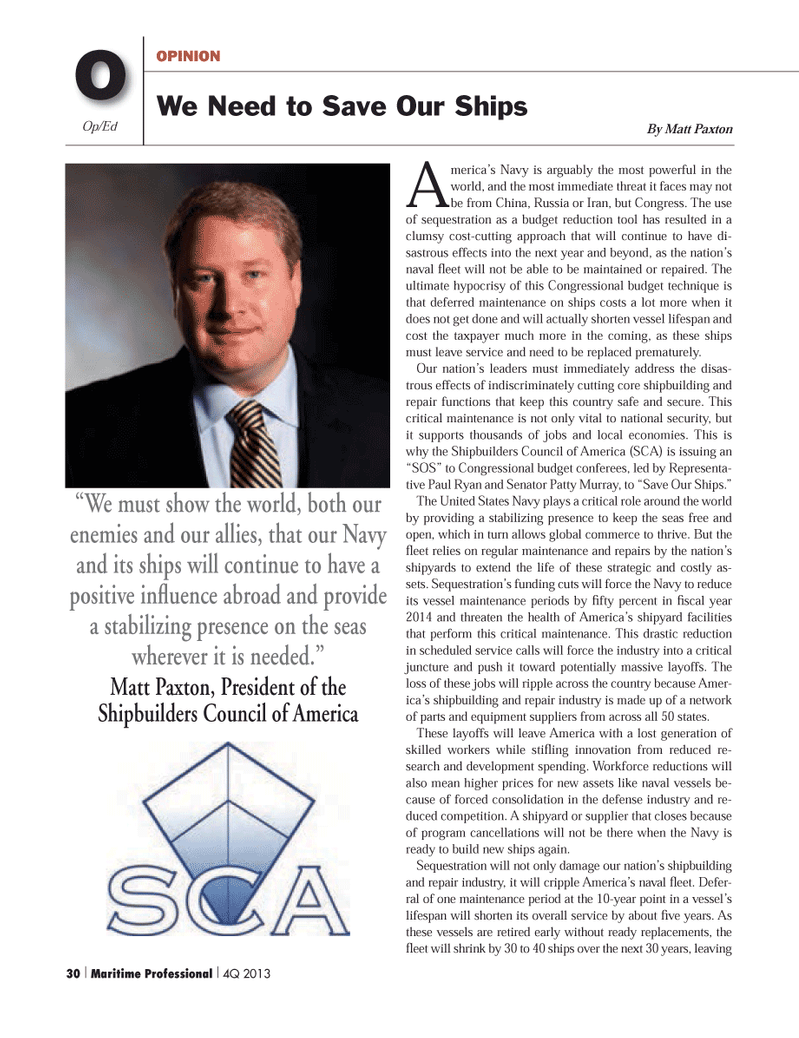
Page 30: of Maritime Logistics Professional Magazine (Q4 2013)
Shipbuilding, Repair
Read this page in Pdf, Flash or Html5 edition of Q4 2013 Maritime Logistics Professional Magazine
America?s Navy is arguably the most powerful in the world, and the most immediate threat it faces may not be from China, Russia or Iran, but Congress. The use of sequestration as a budget reduction tool has resulted in a clumsy cost-cutting approach that will continue to have di- sastrous effects into the next year and beyond, as the nation?s naval eet will not be able to be maintained or repaired. The ultimate hypocrisy of this Congressional budget technique is that deferred maintenance on ships costs a lot more when it does not get done and will actually shorten vessel lifespan and cost the taxpayer much more in the coming, as these ships must leave service and need to be replaced prematurely. Our nation?s leaders must immediately address the disas- trous effects of indiscriminately cutting core shipbuilding and repair functions that keep this country safe and secure. This critical maintenance is not only vital to national security, but it supports thousands of jobs and local economies. This is why the Shipbuilders Council of America (SCA) is issuing an ?SOS? to Congressional budget conferees, led by Representa- tive Paul Ryan and Senator Patty Murray, to ?Save Our Ships.? The United States Navy plays a critical role around the world by providing a stabilizing presence to keep the seas free and open, which in turn allows global commerce to thrive. But the eet relies on regular maintenance and repairs by the nation?s shipyards to extend the life of these strategic and costly as- sets. Sequestration?s funding cuts will force the Navy to reduce its vessel maintenance periods by fty percent in scal year 2014 and threaten the health of America?s shipyard facilities that perform this critical maintenance. This drastic reduction in scheduled service calls will force the industry into a critical juncture and push it toward potentially massive layoffs. The loss of these jobs will ripple across the country because Amer- ica?s shipbuilding and repair industry is made up of a network of parts and equipment suppliers from across all 50 states.These layoffs will leave America with a lost generation of skilled workers while sti ing innovation from reduced re- search and development spending. Workforce reductions will also mean higher prices for new assets like naval vessels be- cause of forced consolidation in the defense industry and re-duced competition. A shipyard or supplier that closes because of program cancellations will not be there when the Navy is ready to build new ships again. Sequestration will not only damage our nation?s shipbuilding and repair industry, it will cripple America?s naval eet. Defer- ral of one maintenance period at the 10-year point in a vessel?s lifespan will shorten its overall service by about ve years. As these vessels are retired early without ready replacements, the eet will shrink by 30 to 40 ships over the next 30 years, leaving Op/EdOPINIONWe Need to Save Our Ships OBy Matt Paxton ?We must show the world, both our enemies and our allies, that our Navy and its ships will continue to have a positive in uence abroad and provide a stabilizing presence on the seas wherever it is needed.? Matt Paxton, President of the Shipbuilders Council of America 30 | Maritime Professional | 4Q 2013MP #4 18-33.indd 30MP #4 18-33.indd 3012/12/2013 2:22:22 PM12/12/2013 2:22:22 PM

 29
29

 31
31
